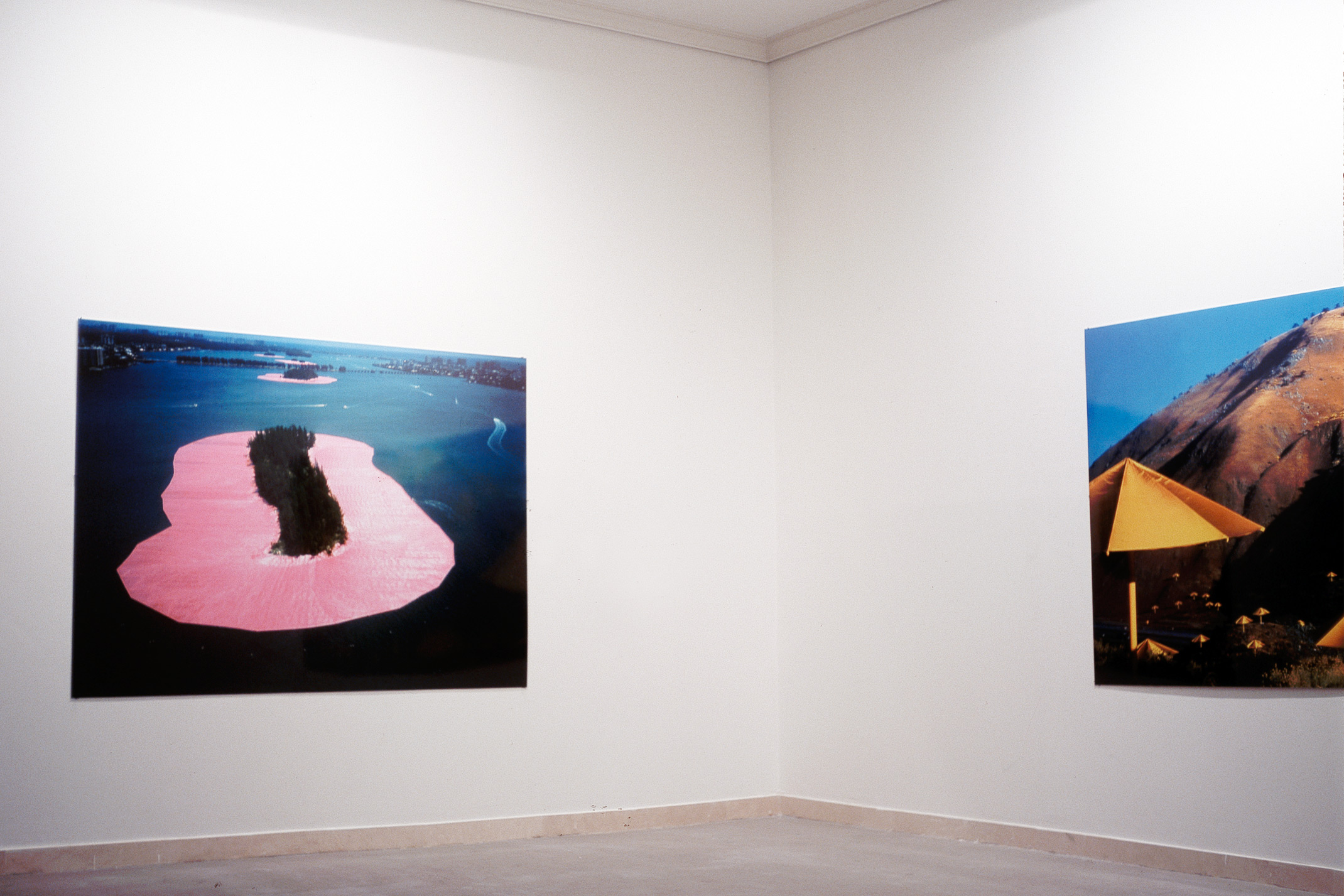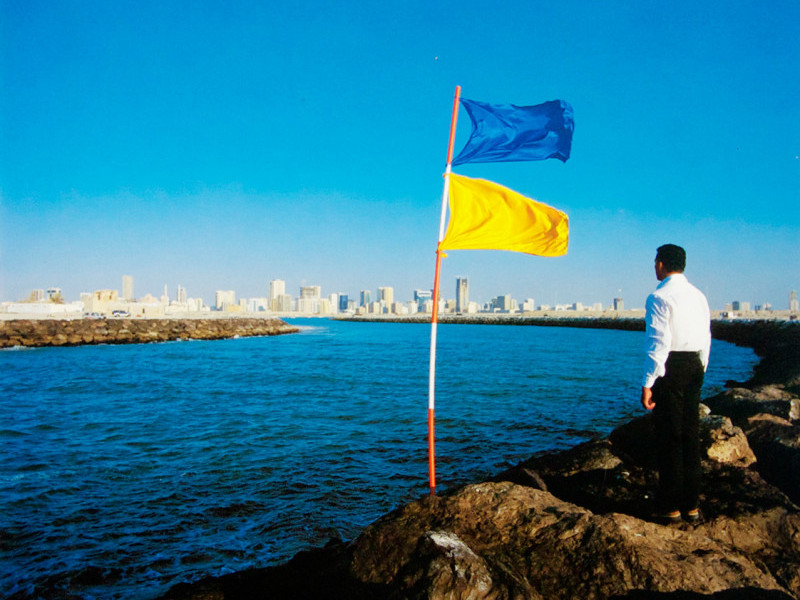
Selected Works, 2003
Christo & Jeanne Claude
Selected Works, 2003
Installation view
search


Christo & Jeanne Claude
Selected Works, 2003
Installation view
At sunrise, on October 9th, 1991, Christo and Jeanne-Claude's 1,880 workers began to open the 3,100 umbrellas in Ibaraki and California, in the presence of the artists at both sites. This Japan-USA temporary work of art reflected the similarities and differences in the ways of life and the use of the land in two inland valleys, one 19 kilometres long (12 miles) in Japan, and the other 29 kilometres long (18 miles) in the USA. In Japan, the valley is located north of Hitachiota and south of Satomi, 120 kilometres (75 miles) north of Tokyo, around Route 349 and the Sato River, in the Prefecture of Ibaraki, on the properties of 459 private landowners and governmental agencies. In the U.S.A., the valley is located 96.5 kilometres (60 miles) north of Los Angeles, along Interstate 5 and the Tejon Pass, between south of Gorman and Grapevine, on the properties of Tejon Ranch, 25 private landowners as well as governmental agencies. Eleven manufacturers in Japan, USA, Germany and Canada prepared the various elements of the umbrellas: fabric, aluminum super-structure, steel frame bases, anchors, wooden base supports, bags and molded base covers. All 3,100 umbrellas were assembled in Bakersfield, California, from where the 1,340 blue umbrellas were shipped to Japan. Starting in December 1990, with a total work force of 500, Muto Construction Co. Ltd. in Ibaraki, and A.L.Huber & Son in California installed the earth anchors and steel bases under the supervision of Site Managers Akira Kato in Japan and Vince Davenport in the USA. The sitting platform-base covers were placed during August and September 1991. From September 19 to October 7, 1991, an additional construction work force began transporting the umbrellas to their assigned bases, bolted them to the receiving sleeves, and elevated the umbrellas to an upright closed position. Each umbrella was 6 metres (19 feet 8 inch) high and 8.66 metres (26 feet 5 inch) in diameter. On October 4, students, agricultural workers, and friends, 960 in USA and 920 in Japan, joined the work force to complete the installation of the umbrellas. Christo and Jeanne-Claude's $26 million temporary work of art was entirely financed by the artists through their "The Umbrellas, Joint Project for Japan and U.S.A. Corporation" (Jeanne-Claude Christo-Javacheff, president). All previous projects by Christo and Jeanne-Claude have been financed in a similar manner through the sale of the studies, preparatory drawings, collages, scale models, early works, and original lithographs. The artists do not accept sponsorships of any kind. The removal started on October 27 and the land restored to its original condition. The umbrellas were taken apart and most of the elements were recycled. The Umbrellas, free standing dynamic modules, reflected the availability of the land in each valley, creating an invitational inner space, as houses without walls, or temporary settlements and related to the ephemeral character of the work of art. In the precious and limited space of Japan, The Umbrellas were positioned intimately, close together and sometimes following the geometry of the rice fields. In the luxuriant vegetation enriched by water year round, The Umbrellas were blue. In the California vastness of uncultivated grazing land, the configuration of The Umbrellas was whimsical and spreading in every direction. The brown hills are covered by blond grass, In that dry landscape, The Umbrellas were yellow. From October 9th, 1991 for a period of eighteen days, The Umbrellas were seen, approached, and enjoyed by the public, either by car from a distance and closer as they bordered the roads, or by walking under The Umbrellas in their luminous shadows.
Surrounded Islands, Biscayne Bay, Greater Miami, Florida. 1980-83. On May 7, 1983 the installation of Surrounded Islands was completed. In Biscayne Bay, between the city of Miami, North Miami, the Village of Miami Shores and Miami Beach, 11 of the islands situated in the area of Bakers Haulover Cut, Broad Causeway, 79th Street Causeway, Julia Tuttle Causeway, and Venetian Causeway were surrounded with 603,850 square meters (6.5 million square feet) of pink woven polypropylene fabric covering the surface of the water, floating and extending out 61 metres (200 feet) from each island into the Bay. The fabric was sewn into 79 patterns to follow the contours of the 11 islands. For 2 weeks Surrounded Island spreading over 11.3 kilometres (7 miles) was seen, approached and enjoyed by the public from the causeways, the land, the water and the air. The luminous pink colour of the shiny fabric was in harmony with the tropical vegetation of the uninhabited verdant island, the light of the Miami sky and the colours of the shallow waters of Biscayne Bay. Since April 1981, attorneys Joseph Z. Fleming, Joseph W. Landers, marine biologist Dr. Anitra Thorhaug, ornithologists Dr. Oscar Owre and Men Cummings, mammal expert Dr. Daniel Odell, marine engineer John Michel, four consulting engineers, and builder-contractor, Ted Dougherty of A & Builders, Inc. had been working on the preparation of the Surrounded Islands. The marine and land crews picked up debris from the eleven islands, putting refuse in bags and carting it away after they had removed some forty tons of varied garbage: refrigerator doors, tires, kitchen sinks, mattresses and an abandoned boat. Permits were obtained from the following governmental agencies: The Governor of Florida and the Cabinet; the Dade County Commission; the Department of Environmental Regulation; the City of Miami Commission; the City of North Miami; the Village of Miami Shores; the U.S. Army Corps of Engineers; the Dade County Department of Environmental Resources Management. From November 1982 until April 1983, 6,500,000 square feet of woven polypropylene fabric were sewn at the rented Hialeah factory, into 79 different patterns to follow the contours of the 11 islands. A flotation strip was sewn in each seam. At the Opa Locka Blimp Hangar, the sewn sections were accordion - folded to ease the unfurling on the water. The outer edge of the floating fabric was attached to a 30.5 centimetre (12 inch) diameter octagonal boom, in sections of the same colour as the fabric. The boom was connected to the radial anchor lines which extended from the anchors at the island to the 610 specially made anchors, spaced at 15.3 metre (50 foot) intervals, 76 metres (250 feet) beyond the perimeter of each island, driven into the limestone at the bottom of the Bay. Earth anchors were driven into the land, near the foot of the trees, to secure the inland edge of the fabric, covering the surface of the beach and disappearing under the vegetation. The floating rafts of fabric and booms, varying from 3.7 to 6.7 metres (12 to 22 feet) in width and from 122 to 183 metres (400 to 600 feet) in length were towed through the Bay to each island. There were 11 islands, but on two occasions, two islands were surrounded together as one configuration. As with Christo and Jeanne-Claude's previous art projects, Surrounded Islands was entirely financed by the artists, through the sale by C.V.J. Corporation (Jeanne-Claude Christo-Javacheff, President) of the preparatory pastel and charcoal drawings, collages, lithographs and early works. The artists do not accept sponsorship of any kind. On May 4, 1983, out of a total work force of 430, the unfurling crew began to blossom the pink fabric. Surrounded Islands was tended day and night by 120 monitors in inflatable boats Surrounded Islands was a work of art which underlined the various elements and ways in which the people of Miami live, between land and water.

Sharjah Biennial 6